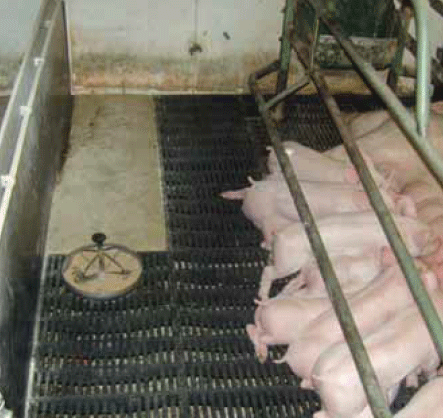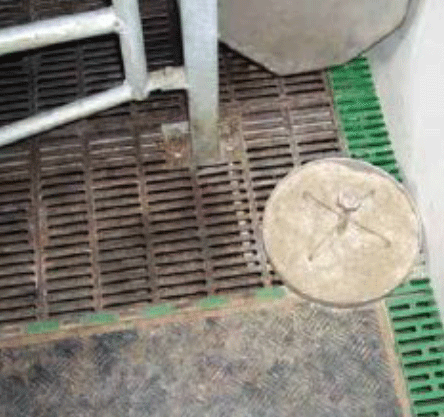



Creep Feeding
Creep feeding is one way to smooth the transition at weaning with minimal performance check, according to the updated No. 5 in the 'Action for Productivity' series from BPEX.Creep feeding is the practice of feeding a solid diet to piglets while they are
suckling the sow, preparing their digestive system for weaning. Creep feeding
initiates and promotes gut and digestive enzyme development, which enables
the piglet to digest nutrients from food sources other than that of milk.
This encourages feed intake, which is one of the greatest challenges to post-weaning
performance.
Creep feeding becomes increasingly important and beneficial as weaning age increases. As piglets grow,
their demand for nutrients similarly grows and with increasing age this demand outstrips the capacity of
the sow to supply them, as the sow’s milk yield peaks at around three weeks and then slowly declines.
Basics of Good Creep Feeding
- Keep creep feed fresh and clean and out of reach of the sow
- Start creep feeding at seven to 10 days of age, or according to the manufacturer's recommendations
- Begin by offering creep on a flat surface, for example, a shallow tray (heavy metal or plastic trays that can hook into the slats)
- Place trays close to the piglets but not under direct heat as this will turn the feed stale too quickly; also, keep feed away from the dunging area
- Begin with very small amounts replaced at least twice a day, preferably more. Always remove all uneaten creep; only unmedicated waste creep can be fed to the sow
- Offer creep when the sows are feeding as piglets are active and unlikely to be suckled for some time
- Do not overfeed - feed to appetite. Litters often eat little and then suddenly begin to eat increasing amounts
- Introduce small troughs or top up the trays more often if litters are eating well
- Clean any fouled trays or troughs
- Store creep feed in a cool place and always close bags to prevent feed taking up the farrowing house odours and/or becoming rancid
- Be committed: creep feeding is more successful the more time and effort is devoted to it
- Remember the importance of the sow: it is crucial to maximise milk yield, she will be providing the majority of the piglet's nutrition; see Action for Productivity 20: Condition scoring
- Utilisation of creep feed should always be considered as a supplement for increased benefit rather than a replacement for milk.
Importance of Creep Feeding
- Proper creep feeding is a very valuable and worthwhile process but it must be done correctly to see the benefits and avoid wastage
- Creep feed gets the piglet used to eating solid feed and makes the piglet familiar with what becomes the sole diet at weaning; studies have also shown that as creep feed intakes rise, post-weaning diarrhoea is reduced
- Supplementing sow milk with creep feed can result in both improved pre- and post-weaning performance, leading to an overall improvement in net return of up to £2 per pig
- Figure 1 illustrates the benefit of creep feeding over relying solely on sow milk
- On average, you should expect a total creep feed intake of 400-600g per piglet when weaning at 26 to 28 days of age, although all units are different. Piglets weaned at 21 days will eat substantially less and those weaned later substantially more
- Whether you are achieving this intake or not (400 to 600g per piglet) make a note of current creep consumption and target an extra 100g per piglet from what you are currently achieving
- Aim for a litter weaning weight of at least 90kg.

Encouraging Creep Intake
- To make the transition as smooth as possible use the same creep pre and immediately post-weaning
- Offer good quality, palatable and highly digestible feed which piglets will find appealing
- Ensure that there is an accessible supply of fresh water as this will influence feed intake
- Sticky meal that sticks to the piglets’ snouts and requires them to lick it may encourage intake
- Pellets and blends of pellets with mash (meal and water) are also very effective, and generally result in less wastage than meal
- Position creep feed away from corners, drinkers and heat lamps to minimise the likelihood of fouling
- If using mats, they should be removed after a few days; creep should then be provided in feeders, which will need careful adjustment
- In each litter some piglets will be eating nothing at all, even when the other piglets are eating well; watch out for these pigs and manage them carefully to prevent them fading.


Increasing weaning weight and daily feed intake post-weaning as a result of good creep feeding results in increased daily gain and improved food conversion ratio post-weaning, delivering a net margin benefit of around £1.20 per pig. Lifetime benefit in growing pig performance can be expected, resulting in a net margin benefit of around £1 to £2 per pig sold or pigs being sold three to four days earlier.
March 2013








